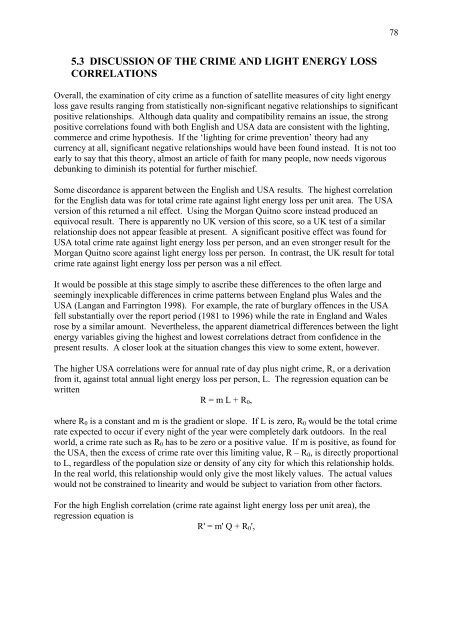Outdoor Lighting and Crime - Amper
Outdoor Lighting and Crime - Amper
Outdoor Lighting and Crime - Amper
You also want an ePaper? Increase the reach of your titles
YUMPU automatically turns print PDFs into web optimized ePapers that Google loves.
5.3 DISCUSSION OF THE CRIME AND LIGHT ENERGY LOSS<br />
CORRELATIONS<br />
Overall, the examination of city crime as a function of satellite measures of city light energy<br />
loss gave results ranging from statistically non-significant negative relationships to significant<br />
positive relationships. Although data quality <strong>and</strong> compatibility remains an issue, the strong<br />
positive correlations found with both English <strong>and</strong> USA data are consistent with the lighting,<br />
commerce <strong>and</strong> crime hypothesis. If the ‘lighting for crime prevention’ theory had any<br />
currency at all, significant negative relationships would have been found instead. It is not too<br />
early to say that this theory, almost an article of faith for many people, now needs vigorous<br />
debunking to diminish its potential for further mischief.<br />
Some discordance is apparent between the English <strong>and</strong> USA results. The highest correlation<br />
for the English data was for total crime rate against light energy loss per unit area. The USA<br />
version of this returned a nil effect. Using the Morgan Quitno score instead produced an<br />
equivocal result. There is apparently no UK version of this score, so a UK test of a similar<br />
relationship does not appear feasible at present. A significant positive effect was found for<br />
USA total crime rate against light energy loss per person, <strong>and</strong> an even stronger result for the<br />
Morgan Quitno score against light energy loss per person. In contrast, the UK result for total<br />
crime rate against light energy loss per person was a nil effect.<br />
It would be possible at this stage simply to ascribe these differences to the often large <strong>and</strong><br />
seemingly inexplicable differences in crime patterns between Engl<strong>and</strong> plus Wales <strong>and</strong> the<br />
USA (Langan <strong>and</strong> Farrington 1998). For example, the rate of burglary offences in the USA<br />
fell substantially over the report period (1981 to 1996) while the rate in Engl<strong>and</strong> <strong>and</strong> Wales<br />
rose by a similar amount. Nevertheless, the apparent diametrical differences between the light<br />
energy variables giving the highest <strong>and</strong> lowest correlations detract from confidence in the<br />
present results. A closer look at the situation changes this view to some extent, however.<br />
The higher USA correlations were for annual rate of day plus night crime, R, or a derivation<br />
from it, against total annual light energy loss per person, L. The regression equation can be<br />
written<br />
R = m L + R0,<br />
where R0 is a constant <strong>and</strong> m is the gradient or slope. If L is zero, R0 would be the total crime<br />
rate expected to occur if every night of the year were completely dark outdoors. In the real<br />
world, a crime rate such as R0 has to be zero or a positive value. If m is positive, as found for<br />
the USA, then the excess of crime rate over this limiting value, R – R0, is directly proportional<br />
to L, regardless of the population size or density of any city for which this relationship holds.<br />
In the real world, this relationship would only give the most likely values. The actual values<br />
would not be constrained to linearity <strong>and</strong> would be subject to variation from other factors.<br />
For the high English correlation (crime rate against light energy loss per unit area), the<br />
regression equation is<br />
R' = m' Q + R0',<br />
78
















